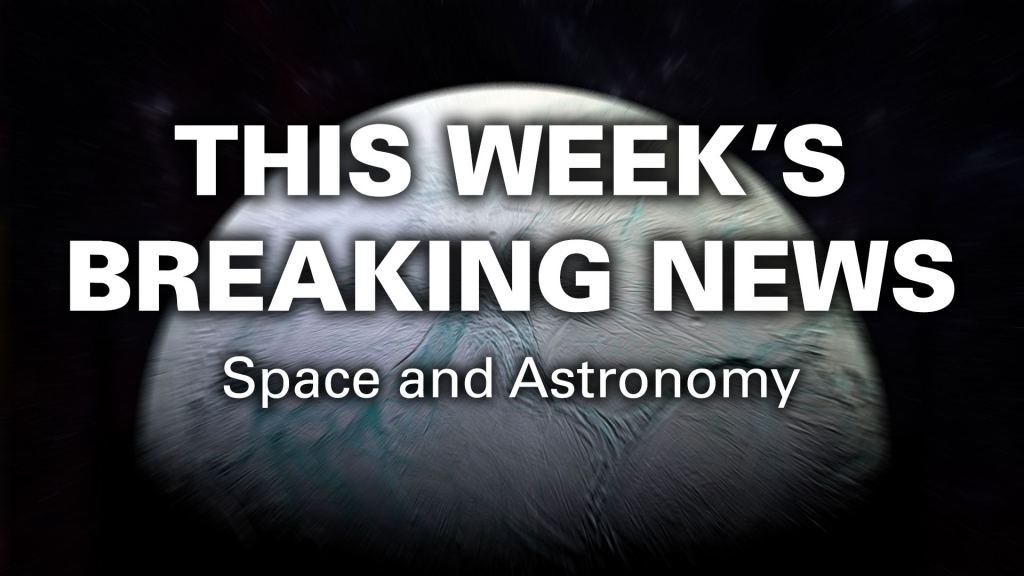Humanity moved an asteroid on purpose for the first time in history. Juno flies past Jupiter’s moon Europa. A possible mission to boost Hubble, and a mysterious blob is orbiting Milky Way’s supermassive black hole.
Here’s a neat TLDR video version of Space Bites. So, you can just sit back, relax, and enjoy this week’s most important space and astronomy news. Humanity avenged the dinosaurs this week, smashing the Double Asteroid Redirection Test (DART) into Dimorphos, the moon of Asteroid Didymos.
NASA hosted a live stream the final hour before impact, showing the asteroid target growth in the spacecraft’s crosshairs until the rock-strewn surface filled the screen. We saw one final full frame of the surface of asteroid Dimorphos, then a partial frame showing the very last data the spacecraft could send home. Remove All Ads on Universe Today Join our Patreon for as little as $3! Get the ad-free experience for life Telescopes worldwide tracked the event, and the wreckage was visible, even in smaller amateur telescopes.
Over the coming weeks and months, we’ll find out if the mission was successful. Did DART change the orbit of Dimorphos enough to measure? More about DART impact . The Hubble Space Telescope is slowly losing altitude, and unless anyone intervenes, it’ll enter the Earth’s atmosphere within the next decade and burn up.
But Hubble is fully operational and oversubscribed by astronomers who rely on it. This week, NASA and SpaceX announced that they’re investigating if it’s feasible to raise the orbit of Hubble and keep it going for decades. The proposal comes from entrepreneur Jared Isaacman, who runs a privately-funded space program called Polaris.
More about SpaceX’s plan for Hubble . Bad weather is always a risk for rocket flights, but Category 4 Hurricane Ian took that to the next level. As the giant hurricane was bearing down on Florida, NASA decided to roll the Space Launch System back to the Vehicle Assembly Building.
This scrubbed any launch possibilities for September and October and pushed the next launch window back to early November. With a launch delay this long, NASA will have to perform a series of maintenance activities on the rocket and its payloads to keep it certified for flight. More about SLS rollback .
There is a new finding by the ALMA telescope that shows that there’s a blob of gas orbiting the Milky Way’s supermassive black hole. Its orbit is roughly the size of Mercury’s orbit. This means that it moves at about 1/3 of the speed of light, which is 100,000 km/s.
Such ‘hot spots’ have been observed before around black holes, but it is the first time to be seen in radio waves. One of the interesting findings is that the orbit of the blob seems to be tilted face-on from our perspective. Very similar to EHT’s predictions of the plane of the Sag A* accretion disk plane.
More about Sag A* mystery . JWST made yet another interesting observation. This time it wasn’t a new nebula or galaxy.
This time it looked at a system of brown dwarfs. They are sometimes called “failed stars”, as they didn’t have enough mass to properly start fusion in their cores. But it doesn’t mean that they can’t be interesting.
So, one of the findings from James Webb’s data is that in the atmosphere of the brown dwarf there was sand. More about sand in failed stars . China’s Zhurong rover has been on Mars for quite a while now.
One of the interesting instruments that it has is a ground penetrating radar. It can see what’s going on tens of meters under the surface. So, based on this instrument’s data, scientists have concluded that there isn’t any water under Mars’ surface.
At least in the Utopia Basin region, where Zhurong currently is. However, by looking at the layers beneath the surface, scientists can more accurately analyze how water flew on Mars in the past. More about China’s rover findings .
Enceladus, Saturn’s icy moon, is one of the most interesting places to visit in our Solar System. We know it has a subsurface ocean of liquid water. We have seen plumes of water bursting into space from the Cassini flybys.
All that is very promising when it comes to potential places to look for extraterrestrial life. And recent findings show that Enceladus is even more habitable than we previously thought. Which makes us wait for a new mission to it even more.
More about Enceladus’ habitability . Jupiter’s moon Europa seems to be one of the best places to search for life in the Solar System. We know a vast ocean of liquid water under a thick ice shell.
Geysers might even spray this water into space from cracks across Europa’s surface. NASA’s Juno spacecraft went in to take a look this week, flying within 352 kilometers of the surface of Europa and capturing this incredible image. This is a sneak preview of the upcoming Europa Clipper mission, which will launch in 2024 and arrive at Europa in 2030.
More about flyby of Europa . If you want to get a curated selection of the most important space and astronomy news every week, subscribe to our Weekly Email Newsletter and get magazine-size ad-free news directly from Fraser Cain. If you prefer the news to be videoed at you, check out our Space Bites playlist on our YouTube channel .
.
From: universetoday
URL: https://www.universetoday.com/157893/spacex-to-boost-hubble-nasa-smashes-asteroid-exciting-enceladus-discoveries/



